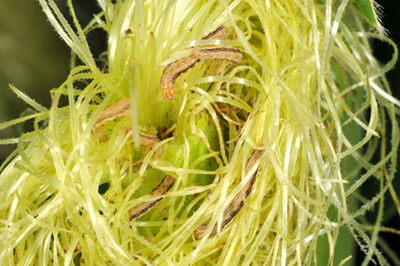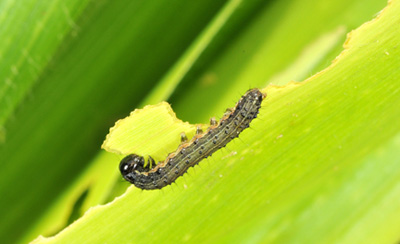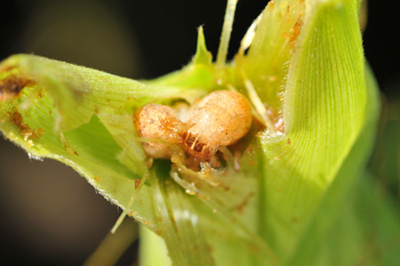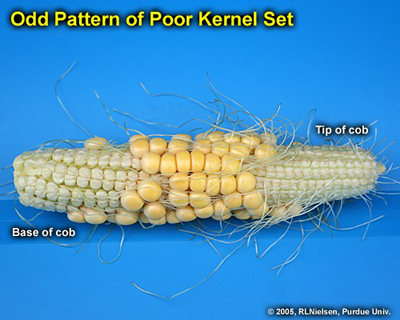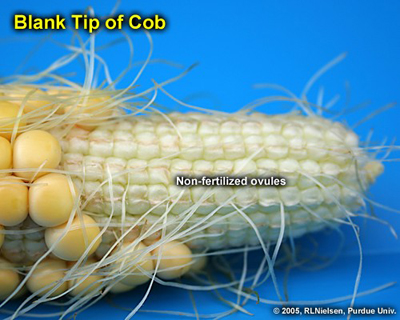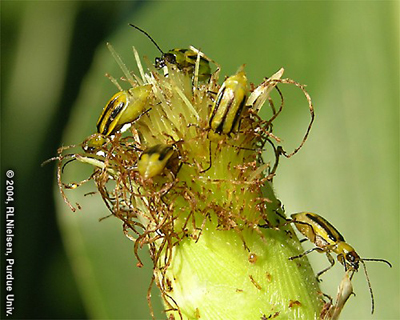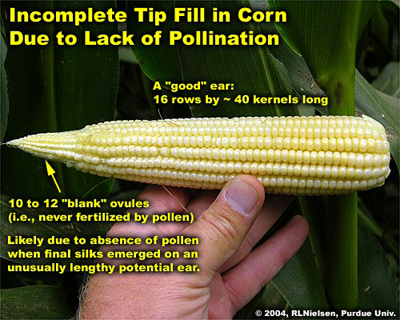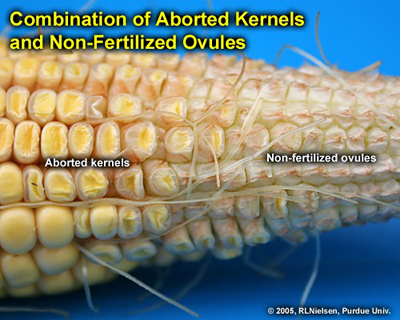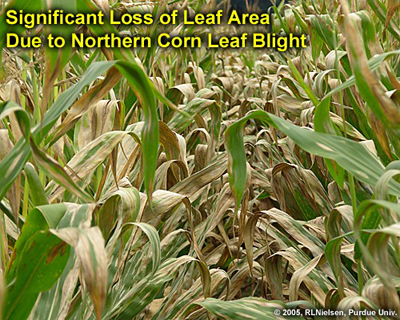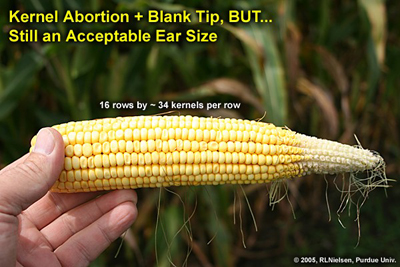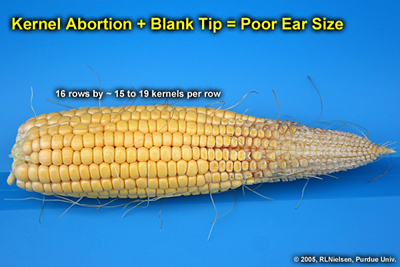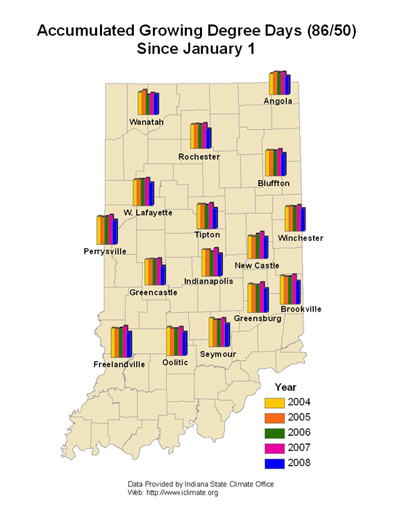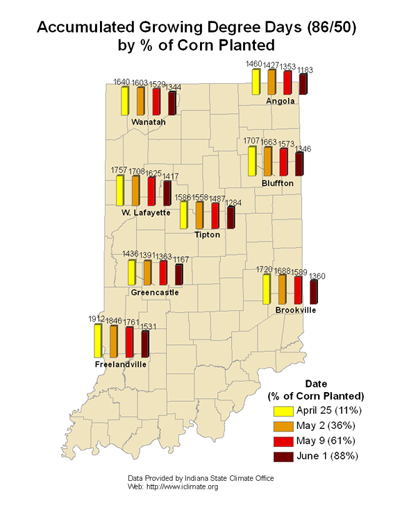Pest & Crop Newsletter, Entomology Extension, Purdue University
Late-Season Worms in Late-Planted Corn – (John Obermeyer)
- Corn earworm, armyworm, fall armyworm, and western bean cutworm have been found.
- Whorl state or pollinating corn will be targeted by these pests.
- Earworm has the potential to take the “insect pest of the year” award.
- Bt corn will have limited control of earworm and/or fall armyworm.
Overall, this has been a low insect pest year, but it’s not over yet. From field visits, calls received, and digital pictures sent, the larvae of several species of moths are making a run at some of the late-planted corn throughout the state. Most of the damage has been minor and scattered throughout fields although some controls have been applied. During field visits in northwest Indiana this week corn earworm, fall armyworm, and western bean cutworm were found.
Rick Foster, Purdue fruit/vegetable extension entomologist, and many cooperators have been tracking corn earworm moths in pheromone traps throughout the season. For viewing updated earworm trap counts, visit <http://extension.entm.purdue.edu/cornearworm/index.php>. It is quite evident that the second-generation earworm moth flight is underway. In field corn that still had yellow silks, finding larvae wasn’t difficult. What surprised me was the number of worms feeding in the silks before entering the ear. There is a misconception that if multiple worms are being found in an ear, that it must be western bean cutworm. It is very common to find more than one earworm per ear, but if they do compete for the same “space,” they are cannibalistic.
Six earworm larvae feeding on silks
Bryan Overstreet, Jasper County CES, sent pictures of second-generation armyworm feeding on late-whorl, early pollinating corn. It is very unusual for armyworm to be found this time of year. However this late-planted corn was no-tilled into rye that was harvested for dairy forage. Just as in the spring, rye is a “magnet” for armyworm moth egg laying.
Fall armyworm moths have been picked up in black light and pheromone traps for some time. I have been expecting calls concerning infestations in late-planted corn, none have been received accept from a seed agronomist in Missouri. During my field visits yesterday, some larvae were found in late-whorl corn. Actually the early-instar larval damage initially deceived me, as I thought the plants were heavily infested with European corn borer. As the larva gets larger, so does their damage, as they create quite a mess of infested plants. Especially in southern Indiana, pest managers should monitor the whorl stage corn for this insect. Larger fall armyworm create a “frass-plug” in the whorl which prevents penetration of insecticides, even with high volume and pressure.
Fall armywrom revealed from within whorl
It is still early, but little damage has been reported of the western bean cutworm. I’ve received one report of some waxy corn that was treated for this insect in a northwestern county. This would be, to my knowledge, the first time western bean cutworm was deemed economic to treat. The pest manager reporting this indicated that most of the larvae were still outside the ear, which of course would be the opportune time to treat. Once inside the ear, larvae will not be controlled. Western bean cutworm moth captures in pheromone have increased over last year, though they were late just as most insects this year. Please report any infestations so that we can document this pest’s damage.
Western bean cutworm at the ear tip, note two black rectangles behind orange head
![]()
Another Soybean Aphid Update – (John Obermeyer)
- Late rally squashed by beating rain.
Populations of soybean aphid in one week’s time were becoming a concern in the northern regions of the Corn Belt. Days after that dramatic increase, winged aphids from that portion of the country had made their way to northern Indiana, riding storm fronts. Though at low densities, a high percentage of plants in some northern Indiana fields had been infested. It looked like the stage was set for a late surge of soybean aphid. Along came the tremendous storms of Sunday and Monday, with driving torrential rains. What do you get with whipping winds, 4-6 inches of rain, and wimpy aphids just colonizing plants…I think you know the answer.
![]()
Scouting For Rust By Land And By Air – (Anne Dorrance, Kiersten Wise (Purdue University) and Don Hershman (University of Kentucky))
As of today no soybean rust pustules have been found in the Midwest, including Ohio, Illinois, Indiana, Kentucky, and Missouri.
As most of you know, soybean leaves are collected from sentinel plots established throughout the state on a weekly basis and sent to laboratories where they are closely examined for soybean rust. In addition to the sentinel plots, there are numerous spore traps monitored regularly for spores of the soybean rust fungus (Phakopsora pachyrhizae) throughout the US. This year, we are primarily monitoring rain traps in a joint project with the United Soybean Board and USDA-ARS. Each year that these traps have been monitored (2005-2007), they have been positive for spores during June, July and August. This pattern has continued for 2008.
Spores of the soybean rust fungus are killed by UV radiation (sunlight) and by dessication. These are just two of the many research findings over the past few years. Thus, it is highly likely that for most of the spore finds to date, the spores are dead by the time they reach the spore trap, hundreds of miles from the original source. The lack of documented soybean rust in numerous northern states that have had frequent rust spore finds over the past three years is evidence for this statement. Unfortunately, current methodology can only detect the presence of spores, but cannot test for viability. In addition, the spore finds have been light. Thus, if infections did occur it would be in the range of one pustule on one leaf in 10 acres. At this rate, it would take until late September to find the one plant that had the infection.
We have also had a lot of rain this year, especially during June and early July. However, in many areas the “faucet” turned off until recently (or it is still dry), making it very unfavorable for rust development. If any infections were associated with any of the spores finds this years, unfavorable conditions would delay development.
When spore traps indicate that spores of the rust fungus are found, we intensify soybean rust field monitoring efforts. To this end, requests have gone out to the Ohio, Kentucky and Indiana soybean rust sentinel networks to increase the number of soybean leaves collected in sentinel plots, and to increase mobile scouting efforts in areas that have even the slightest chance that favorable weather conditions may have resulted in soybean rust infections.
At this time we are not recommending fungicide applications be made for soybean rust management. If we do find soybean rust this week, it will still not be at the level that requires immediate treatment. This is one of huge difference between Brazil and the Midwest. Our initial levels of soybean rust spores are very, very low compared to Brazil. This gives us extra time to apply fungicides, if they are indeed they needed at all. For April planted soybeans in Ohio and Indiana (May-planted in Kentucky), that are at R5 – these are “out of the woods”. However, we are continuing to monitor fields for soybean rust since later planted soybeans are still at some risk.
If soybean rust infection is suspected in any field, we request that samples be forwarded immediately to the State Extension Specialist for diagnosis. Official confirmation of soybean rust can only be made at the state level, and crop insurance claims cannot be processed without accurate diagnosis. Note: Ohio still has not recorded its first find and must meet APHIS requirements for a new invasive pathogen. If soybean rust is confirmed in a location, extension personnel and CCA’s throughout the state will be notified, and the most current information and management recommendations will be posted on the USDA National Soybean Rust website: <http://www.sbrusa.net>.
Kernel Set Scuttlebutt - (Bob Nielsen)
“Scuttlebutt”: The cask of drinking water on ships was called a scuttlebutt and since sailors exchanged gossip when they gathered at the scuttlebutt for a drink of water, scuttlebutt became U.S. Navy slang for gossip or rumors. A butt was a wooden cask, which held water or other liquids; to scuttle is to drill a hole, as for tapping a cask.
Nautical Terms and Phrases, NAVAL HISTORICAL CENTER, Washington DC 20374-5060. Online at <www.ussbrainedd630.com/terms.htm> [URL accessed 8/4/08].
The post-pollination scuttlebutt overheard in coffee shops throughout Indiana during late summer often revolves around the potential for severe stress that might reduce kernel set or kernel size in neighborhood cornfields. Growers’ interest in this topic obviously lies with the fact that the number of kernels per ear is a rather important component of total grain yield per acre for corn.
Poor kernel set, meaning an unacceptably low kernel number per ear, is not surprising in fields that are obviously severely stressed by drought, but can also occur in fields that otherwise appear to be in good shape. Good or poor kernel set is determined from pollination through the early stages of kernel development; typically 2 to 3 weeks after pollination is complete.
Problems with kernel set stem from ineffective pollination, kernel abortion, or both. Distinguishing between these two symptoms is easy. Determining the exact cause of the problem is sometimes difficult.
Potential Yield Loss
The potential loss in grain yield caused by lower kernel numbers per ear can be estimated using the formula of the so-called Yield Component Method first described by the Univ. of Illinois many years ago (Univ. of Illinois, 2007; Nielsen, 2007a). For example, the loss of only 1 kernel per row for a hybrid with 16-row ears and a stand count of 30,000 ears per acre would equal a potential yield loss of approximately 5 bushels per acre (1 [kernel] x 16 [rows] x 30 [thousand ears per acre] divided by 90 [thousand kernels per bushel]).
Ineffective Pollination
Poor kernel set may be caused by ineffective pollination and the subsequent failure to fertilize ovules on the cob. Ineffective pollination is characterized by an absence of noticeable kernel development. In other words, all you see is cob tissue. Pollination problems may be due to several stress factors this year, sometimes working together to influence kernel set.
Severe drought stress, aggravated by excessive heat, can delay silk emergence to the extent that pollen shed is complete or nearly complete by the time the silks finally emerge from the husk. Without a pollen source, ovule fertilization cannot occur.
Persistent severe silk clipping by insects such as the corn rootworm beetle or Japanese beetle throughout the active pollen shed period can also limit the success of pollination. The simultaneous effects of severe drought stress on silk emergence can easily amplify the consequences of severe silk clipping.
Severe drought stress coupled with excessive heat and low humidity can sometimes desiccate emerged silks to the point that they are no longer receptive to pollen grain germination. I suspect this is low on the list of possible stressors for Indiana most years (because of our typically high humidity levels), but may play a role in some fields once in a while. Similarly, I doubt that pollen viability is usually an issue for Indiana cornfields because temperatures in the low 90’s are usually not great enough to kill pollen.
Consecutive days of persistent rainfall or showers that keep tassels wet for many hours of a day can delay or interfere with anther exsertion and pollen shed. Such a weather period does not typically occur in Indiana, but the remnants of Hurricane Dennis that visited many parts of Indiana in early July of 2005 may have influenced kernel set in some fields that were trying to pollinate during that week as a result of the many days of showery humid weather (coupled with the excessive cloudiness and its effect on photosynthesis).
Exceptionally long potential ears resulting from good weather during ear size determination (not an issue for some Indiana fields this year) sometimes fail to pollinate the final kernels near the tip of the cob. Remember, butt silks emerge first and tip silks emerge last. With oversized ears, sometimes those tip silks emerge after all the pollen has been shed. See the “Word to the Wise” below.
Kernel Abortion
Poor kernel set can also be a reflection of kernel abortion following successful fertilization of the ovules on the cob. In contrast to ineffective pollination, initial kernel development obviously precedes kernel abortion, so the symptoms are usually shriveled remnants of kernels that may be whitish- or yellowish-translucent.
Kernel abortion results from severe stresses that greatly reduce the overall photosynthetic output of the plant very early in the post-pollination grain-filling period. Obvious photosynthetic stressors include severe drought & heat stress, consecutive days of excessively cloudy weather and significant loss of photosynthetically active leaf area (e.g., hail damage, leaf diseases, insect damage, nutrient deficiency).
Warm nights during pollination and early grain fill may indirectly affect survival of developing kernels. Research suggests that the increased rate of kernel development due to warmer temperatures lowers the available amount of photosynthate per unit of thermal time; which then becomes a stressor to kernel development particularly at the tip of the ear, leading to kernel abortion (Cantarero et. al., 1999).
Final Word to the Wise
A plethora (meaning a whole lot) of blank cob tips can quickly ruin the joy of walking a cornfield in the middle of August. Before getting too bent out of shape over the missing kernels, remember to count the number of harvestable kernels on those ears. Sometimes, ears exhibit 1 to 2 inches of blank tips; yet still contain 16 rows by 30 to 35 harvestable kernels per row. Those are perfectly acceptable ear sizes in a year where dry weather has been a concern.
Related References
Cantarero, M.G., A.G. Cirilo, and F.H. Andrade. 1999. Night temperature at silking affects kernel set in maize. Crop Sci 39:703-710.
Nielsen, R.L. (Bob). 2004. Yield Loss Potential During Grain Fill. Corny News Network, Purdue Univ. [On-Line]. Available at <http://www.kingcorn.org/news/articles.04/GrainFillStress-0705.html> [URL accessed 8/4/08].
Nielsen, R.L. (Bob). 2007a. Estimating Corn Grain Yield Prior to Harvest. Corny News Network, Purdue Univ. [On-Line]. Available at <http://www.kingcorn.org/news/timeless/YldEstMethod.html> [URL accessed 8/4/08].
Nielsen, R.L. (Bob). 2007b. Grain Fill Stages in Corn. Corny News Network, Purdue Univ. [On-Line]. Available at <http://www.kingcorn.org/news/timeless/GrainFill.html> [URL accessed 8/4/08].
Nielsen, R.L. (Bob). 2007c. Silk Emergence. Corny News Network, Purdue Univ. Available [On-Line]. Available at <http://www.kingcorn.org/news/timeless/Silks.html> [URL accessed 8/4/08].
Nielsen, R.L. (Bob). 2007d. Tassel Emergence & Pollen Shed. Corny News Network, Purdue Univ. Available [On-Line]. Available at <http://www.kingcorn.org/news/timeless/Tassels.html> [URL accessed 8/4/08].
Univ. of Illinois. 2007. Estimating Corn Yields. (An Online Calculator). Illinois Agronomy Handbook. [On-Line]. Available at <http://www.ag.uiuc.edu/iah/index.php?ch=ch2/est_corn_yield.html> [URL accessed 8/4/08].
![]()
Toadstranglers in August: Good or Bad for the Corn Crop? - (Bob Nielsen)
Folks often joke that the Chicago Board of Trade reacts to whatever the weather is doing in downtown Chicago. Well, this Extension corn specialist freely admits that the torrential rainfall occurring outside the windows of Lilly Hall this morning has caught his attention. What are the consequences of excessive rainfall now that much of the state’s corn crop is moving into the grain filling period? As you might expect, the answer is “it depends”.
Obviously, torrential rain plus strong winds often result in stalk breakage (aka “green snap”) or root lodging (plants uprooted and laying nearly flat to the ground). The yield effect of “green snap” damage depends on the percentage of field affected and whether the stalk breakage occurs above or below the ear, but is usually serious regardless. Obviously, stalk breakage below the ear results in zero yield for that plant. Stalk breakage above the ear results in significant yield loss due to the loss of upper canopy photosynthesis capacity for that plant.
Root lodged corn will recover or straighten up to varying degrees depending on the growth stage of the crop. Generally, younger corn has a greater ability to straighten up with minimal “goose-necking” than older corn. Root lodged corn that is beyond the silking stage of development will likely not straighten back up. Yield effects of root lodging depend on whether soil moisture remains adequate for root regeneration, the severity of root damage due to the uprooting nature of root lodging, and the degree of “goose-necking” that develops and its effect on the harvestability of the crop.
Outright flooding of low-lying fields along rivers or creeks this late in the season can cause several problems for a corn crop. Deposits of sediment and crop residues often remain on crop plants once the water recedes that either outright smother any surviving plants or greatly reduce their ability to capture sunlight and photosynthesize carbohydrates until subsequent rain washes it off the plants. Mud and crud that cakes the leaves and stalks encourage subsequent development of fungal and bacterial diseases in damaged plant tissue. Further physical crop damage (soil erosion, washing away of plants, lodging of plants, and plant tissue damage) occurs from the force of the flowing water on land adjacent to flooded creeks and rivers as well as from any debris caught up in the floodwaters.
Soil oxygen is quickly depleted in ponded areas of fields or areas that are simply poor drained and remained saturated for days after a serious rain event. With typical summer temperatures, such oxygen deprivation quickly takes its toll on the root system of a full-size corn crop. Damage to a corn plant’s root system today will predispose the crop to the development of root and stalk rots later by virtue of the photosynthetic stress imposed by the limited root system during the important grain filling period. Growers should monitor affected fields later in August or early September for the possible development of stalk rots and modify harvest-timing strategies accordingly.
The good news is that fields not seriously impacted by flooding, ponding, or wind damage from recent toadstranglers will likely benefit from such mid-summer rainfall. That old adage that “rain in July makes corn” is true, but rainfall in August is always welcome to ensure adequate soil moisture during the all-important grain filling period.
As of yesterday (4 Aug), areas of northcentral and northeast Indiana had only received 1 to 3 inches of rain during the past 30 days (see accompanying graphic). Non-irrigated sandy fields in those areas of Indiana have likely suffered irrecoverable yield losses due to moisture deficits, but will nevertheless respond to current or subsequent rainfall. Rainfall amounts throughout the remainder of the state over the past 30 days have been a bit more plentiful, but many corn growers will be thankful for any rain they receive during the remainder of the month.
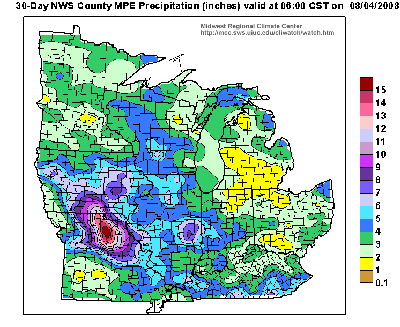
Related References
Midwest Regional Climate Center. 2008. Climate Watch. [On-line]. Available at <http://mcc.sws.uiuc.edu/cliwatch/watch.htm>. [URL accessed 8/5/08].
Nielsen, R.L. (Bob). 2003a. Bacterial Ear Rot in Corn Due to Flooding. Corny News Network, Purdue Univ. [On-line]. Available at <http://www.kingcorn.org/news/articles.03/EarRot-0720.html>. [URL accessed 8/5/08].
Nielsen, R.L. (Bob). 2003b. Corn & Soybean Loss From Floods & Ponding. Corny News Network, Purdue Univ. [On-line]. Available at <http://www.kingcorn.org/news/articles.03/Flooding-0717.html>. [URL accessed 8/5/08].

